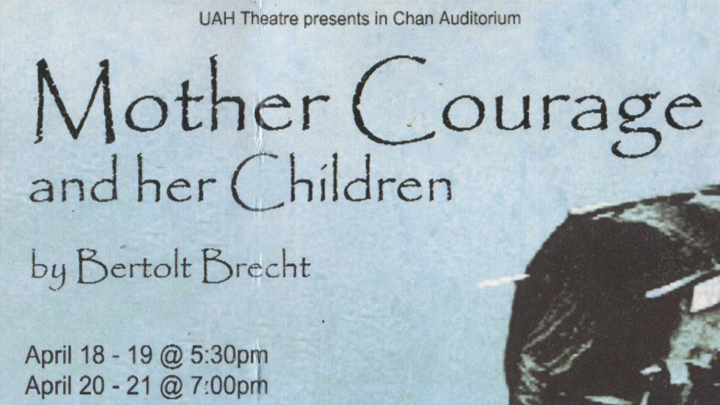
Set in the seventeenth century, the play follows Anna Fierling – "Mother Courage" – an itinerant trader, as she pulls her wagon of wares and her children through the blood and carnage of Europe's religious wars.
Download "Mother Courage and Her Children" theatre program
Mother Courage at UAH: a Review
by Sandy Shattuck
The University of Alabama in Huntsville Theatre program is presenting Bertolt Brecht's Mother Courage and Her Children, which will run through this weekend. I got to see the second performance last night and left the theatre still thinking about some of the scenes. We read the play in ENG 102 and everyone will write a review, so here's my contribution.
Mother Courage is not an easy piece to stage — I don't think any Brecht piece is all that easy to stage, especially if one attempts a real Brechtian production. But UAH Theatre gave us a good taste of epic theatre (also known as dialectic theatre).
Set design in this production is really strong, especially given challenges such as the small size of Chan Auditorium stage and the huge prop at the heart of Mother Courage: the cart. This set addresses those challenges by including two raised platforms (the stage left platform is about a foot higher and extends to the very end of stage left, while the stage right platform is raised only a few inches and extends a bit over the stage) and a small but tall wooden structure stage right that serves as storage space for props needed in various scenes and as the peasant barn that Kattrin climbs at the end of the play.
The platforms function in several ways: they give actors more room, especially since the cart takes up most of the central stage; they allow clear focal points for parts of scenes or when actors sing; they facilitate simultaneous scenes, such as when the Commander praises Eilif while Mother Courage haggles over the sale of a capon with the Cook; and they allow actors places to sit or posture (Kattrin sits on the stage left platform while the Chaplain sings, Mother Courage and the Cook dangle their legs over the stage right platform as they talk).
Mother Courage's cart, without which she is nothing, as she says, is wheeled in at the start of the play and stays on stage for the duration. Each scene, the cart is moved slightly to better facilitate the action. Almost a character itself, the cart also serves to store props and to keep Kattrin hidden at times. From inside the cart, Kattrin changes the flag depending on which country or religion Mother Courage decides to side with.
Lighting is nothing fancy but effective. Usually somewhat muted, the lighting changes to bright spotlight when someone sings. The Brechtian posters announcing what will happen during a scene have been replaced by slides from a data projector thrown onto the back center stage wall. The lighting from the data projector and the blue-ish patterned background of the slide provide another eerie layer of light in between scenes. The data projector might have been used to even more creative Brechtian effect (more commentary on the action? more interruption?), and I also wondered why the full caption for each scene was not displayed.
Below stage left stands the piano, sheet music lit by a slightly orange light. Rolf Goebel (UAH professor of German) plays the excellent score. The piano sounds slightly tinny, which adds to the Brechtian use of music. The actors' singing varies widely in quality. This is a good thing in epic theatre, since the audience should not be lulled into identification with the actor and should not romanticize through song. Other sound effects are either recorded (gun and cannon shots) or spoken. Piano and sound effects never upstage the actors. Sound in this production creates synergy.
As for the cast — they're energetic, highly competent, and often inspired. Kate Chiroux wears Mother Courage like a second skin, never faltering in lines, movement, or song. This makes her a little bit too sympathetic and by the end of the play, we're rooting for her more than we should be. This is true for the entire cast, none of whom plays in Brechtian style. That's OK. To act the way Brecht prescribes has got to be a tough task, since it demands a counter-intuitive, postmodern commentary on one's role. I read somewhere that the ideal Mother Courage acts as if she (the actress) is mad at the character. How does one achieve that?
Kattrin's character, who is dumb, requires lots of physicality in order to communicate, and Elizabeth Baxley relies on her ballet background to traverse the stage. Her final scenes (banging on the drum to warn the village, laughing at the possibility of being killed, lying limp in Mother Courage's arms) work well.
David Wood as the Chaplain and Shawn Tracey as the Cook both do admirable jobs with their singing and speaking parts. The whole cast works very well together. This indicates a fine director at work.
Go see Mother Courage and Her Children. It's rare to catch a Brecht play, and UAH Theatre is proving to be a place to find good drama. This past summer, Meryl Streep as Mother Courage and Kevin Kline as the Cook performed at a free Central Park production directed by George C. Wolfe, with script newly translated by Tony Kushner. New York City has nothin' on Huntsville!